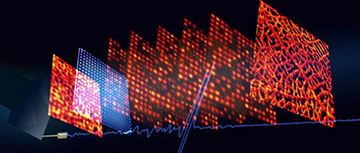
Multifocal optical-resolution photoacoustic microscopy through an ergodic relay (MFOR-PAMER) shortens the scanning time while maintaining a simple and economic setup. [Image: Yang Li, Terence T. W. Wong, Junhui Shi, Hsun-Chia Hsu and Lihong V. Wang]
Because light scatters so strongly in biological tissues, purely optical imaging techniques have a short leash when it comes to probing depths beneath the surface. Sound scatters a thousand times less than light in these situations, which has led scientists to develop hybrid optical-acoustic imaging methods.
Researchers at the California Institute of Technology, USA, report on one of these hybrid methods, a new variation of a photoacoustic microscopy system that is faster, smaller, and cheaper than others of its kind (Light: Science & Applications, doi: 10.1038/s41377-020-00372-x). It can reduce the imaging time of a histology sample from several hours to less than a minute, paving the way for rapid, label-free diagnoses of cancer and other diseases.
Low complexity, high resolution
Photoacoustic microscopy uses a pulsed laser to illuminate a sample, which heats up the molecules inside. The rise in temperature leads to thermoelastic expansion of the tissue, generating acoustic waves that can be detected by ultrasonic transducers. The result is a map of optical absorption within the sample, which depends on the concentrations of things like hemoglobin, water or lipids.
For the current study, OSA Fellow Lihong V. Wang and his colleagues wanted to develop a new type of photoacoustic microscopy system that combined a fast imaging speed with low complexity and cost. A method previously created by Wang’s group, called multifocal optical-resolution photoacoustic tomography (MFOR-PACT), boosted imaging speed by adding a microlens array with multiple optical foci and an ultrasonic transducer array to a traditional setup. These modifications got rid of the bottleneck of slow mechanical scanning across the sample to form an image.
“Applications of the MFOR-PACT system were limited because of the size and complexity of the array-based photoacoustic tomography system,” said Yang Li, the study’s first author.
Improving scanning time
The solution was to replace the array-based design with one that used a single-element ultrasonic transducer through an ergodic relay, which scrambles acoustic pulses based on their origin. A light-transparent, right-angle prism served as the ergodic relay that could then collect photoacoustic signals from the entire field-of-view with a single laser shot.
Li and his colleagues validated the new technique, called multifocal optical-resolution photoacoustic microscopy through an ergodic relay (MFOR-PAMER), with in vitro and in vivo experiments. For example, they successfully imaged blood vessels in a mouse ear with an optical resolution of 13 microns. In addition, MFOR-PAMER achieves a 400-fold improvement in scanning time compared with a traditional photoacoustic microscopy system at the same resolution.
“One of the useful applications that we envisioned is using UV illumination for high-speed, label-free histological study of biological tissues,” said Li. “A conventional UV-based optical-resolution photoacoustic microscopy system required several hours to image a histology sample. Our system can potentially reduce the imaging time to less than a minute, which will be a significant improvement in efficiency in clinical settings.”
